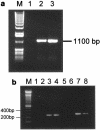Two TonB systems in Actinobacillus pleuropneumoniae: their roles in iron acquisition and virulence
- PMID: 14742511
- PMCID: PMC321588
- DOI: 10.1128/IAI.72.2.701-708.2004
Two TonB systems in Actinobacillus pleuropneumoniae: their roles in iron acquisition and virulence
Abstract
Iron acquisition in vivo by Actinobacillus pleuropneumoniae depends upon a functional TonB system. Tonpitak et al. (W. Tonpitak, S. Thiede, W. Oswald, N. Baltes, and G.-F. Gerlach, Infect. Immun. 68:1164-1170, 2000) have described one such system, associated with tbpBA encoding the transferrin receptor, and here we report a second, termed tonB2. This gene cluster (exbB2-exbD2-tonB2) is highly homologous to those in other Pasteurellaceae, unlike the earlier system described (now termed tonB1), suggesting that it is the indigenous system for this organism. Both tonB2 and tonB1 are upregulated upon iron restriction. TonB2, but not TonB1, was found to be essential for growth in vitro when the sole source of iron was hemin, porcine hemoglobin, or ferrichrome. In the case of iron provided as iron-loaded porcine transferrin, neither tonB mutant was viable. The tonB1 phenotype could be explained by a polar effect of the mutation on transcription of downstream tbp genes. We propose that TonB2 is crucial for the acquisition of iron provided in this form, interacting with accessory proteins of the TonB1 system that have been demonstrated to be necessary by Tonpitak et al. TonB2 appears to play a much more important role in A. pleuropneumoniae virulence than TonB1. In an acute porcine infection model, the tonB2 mutant was found to be highly attenuated, while the tonB1 mutant was not. We hypothesize that acquisition of the tonB1-tbp gene cluster confers a biological advantage through its capacity to utilize transferrin-iron but that TonB1 itself plays little or no part in this process.
Figures








Similar articles
-
Roles of the TonB1 and TonB2 proteins in haemin iron acquisition and virulence in Riemerella anatipestifer.Microbiology (Reading). 2015 Aug;161(8):1592-1599. doi: 10.1099/mic.0.000123. Microbiology (Reading). 2015. PMID: 26293113
-
Characterization of two TonB systems in marine fish pathogen Vibrio alginolyticus: their roles in iron utilization and virulence.Arch Microbiol. 2008 Nov;190(5):595-603. doi: 10.1007/s00203-008-0407-1. Epub 2008 Jul 16. Arch Microbiol. 2008. PMID: 18629473
-
The two TonB systems of Vibrio cholerae: redundant and specific functions.Mol Microbiol. 2001 Feb;39(3):801-12. doi: 10.1046/j.1365-2958.2001.02273.x. Mol Microbiol. 2001. PMID: 11169119
-
Surface polysaccharides and iron-uptake systems of Actinobacillus pleuropneumoniae.Can J Vet Res. 2004 Apr;68(2):81-5. Can J Vet Res. 2004. PMID: 15188950 Free PMC article. Review.
-
Actinobacillus pleuropneumoniae: pathobiology and pathogenesis of infection.Microbes Infect. 2002 Feb;4(2):225-35. doi: 10.1016/s1286-4579(01)01534-9. Microbes Infect. 2002. PMID: 11880056 Review.
Cited by
-
Catecholamines promote Actinobacillus pleuropneumoniae growth by regulating iron metabolism.PLoS One. 2015 Apr 7;10(4):e0121887. doi: 10.1371/journal.pone.0121887. eCollection 2015. PLoS One. 2015. PMID: 25849041 Free PMC article.
-
Cloning, expression, and characterization of TonB2 from Actinobacillus pleuropneumoniae and potential use as an antigenic vaccine candidate and diagnostic marker.Can J Vet Res. 2011 Jul;75(3):183-90. Can J Vet Res. 2011. PMID: 22210994 Free PMC article.
-
Transcriptional profiling of Actinobacillus pleuropneumoniae under iron-restricted conditions.BMC Genomics. 2007 Mar 13;8:72. doi: 10.1186/1471-2164-8-72. BMC Genomics. 2007. PMID: 17355629 Free PMC article.
-
Iron Acquisition Systems of Gram-negative Bacterial Pathogens Define TonB-Dependent Pathways to Novel Antibiotics.Chem Rev. 2021 May 12;121(9):5193-5239. doi: 10.1021/acs.chemrev.0c01005. Epub 2021 Mar 16. Chem Rev. 2021. PMID: 33724814 Free PMC article. Review.
-
HasB, the Serratia marcescens TonB paralog, is specific to HasR.J Bacteriol. 2008 Jan;190(1):21-7. doi: 10.1128/JB.01389-07. Epub 2007 Oct 19. J Bacteriol. 2008. PMID: 17951376 Free PMC article.
References
-
- Alm, R. A., L. S. Ling, D. T. Moir, B. L. King, E. D. Brown, P. C. Doig, D. R. Smith, B. Noonan, B. C. Guild, B. L. deJonge, G. Carmel, P. J. Tummino, A. Caruso, M. Uria-Nickelsen, D. M. Mills, C. Ives, R. Gibson, D. Merberg, S. D. Mills, Q. Jiang, D. E. Taylor, G. F. Vovis, and T. J. Trust. 1999. Genomic-sequence comparison of two unrelated isolates of the human gastric pathogen Helicobacter pylori. Nature 397:176-180. - PubMed
-
- Baltes, N., W. Tonpitak, I. Hennig-Pauka, A. D. Gruber, and G. F. Gerlach. 2003. Actinobacillus pleuropneumoniae serotype 7 siderophore receptor FhuA is not required for virulence. FEMS Microbiol. Lett. 220:41-48. - PubMed
-
- Bog, Y. S., L. O. Andresen, L. Bastholm, F. Elling, O. Angen, and P. M. Heegaard. 2001. The transferrin receptor of Actinobacillus pleuropneumoniae: quantitation of expression and structural characterization using a peptide-specific monoclonal antibody. Vet. Microbiol. 81:51-64. - PubMed
Publication types
MeSH terms
Substances
Associated data
- Actions
- Actions
Grants and funding
LinkOut - more resources
Full Text Sources
Other Literature Sources
Medical

